Nonprofit Technology & Fundraising Blog
Subscribe to our mailing list
June 28, 2022 | Donor Acquisition, DonorPerfect Conference, Fundraising Communication, Storytelling
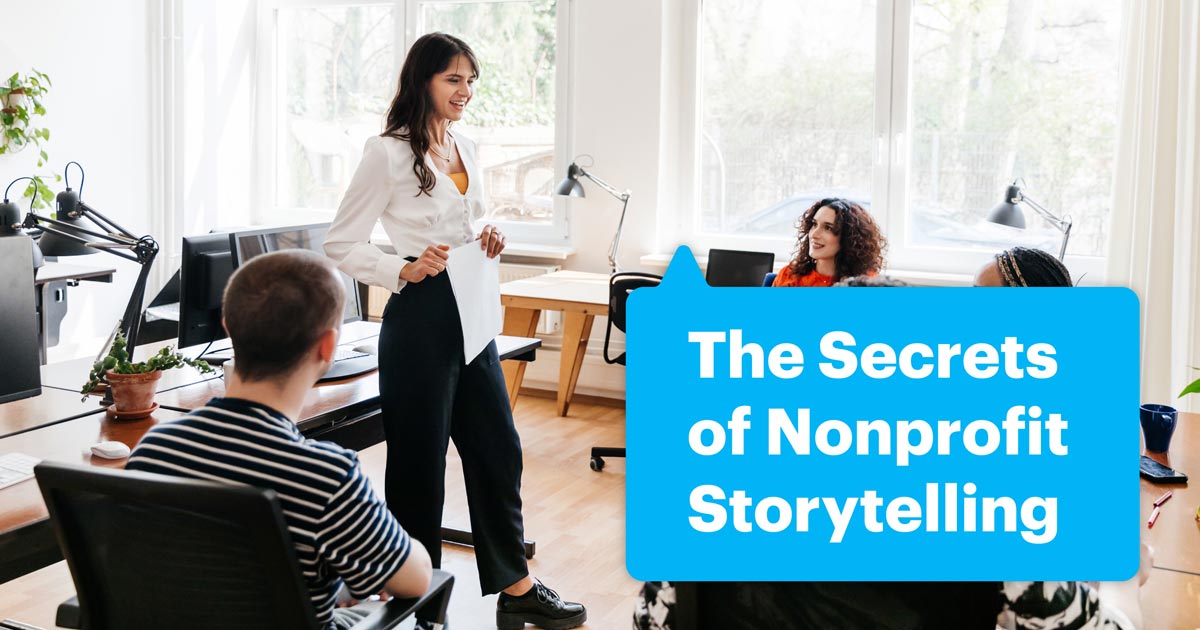
We handpicked industry experts to lead virtual sessions on nonprofit storytelling techniques that promote fundraising growth and success. Even though the conference is over, there’s enough value in these sessions to influence your campaigns for years to come, and we want to share as much of our speakers’ knowledge as possible. Here are highlights from Day 2!
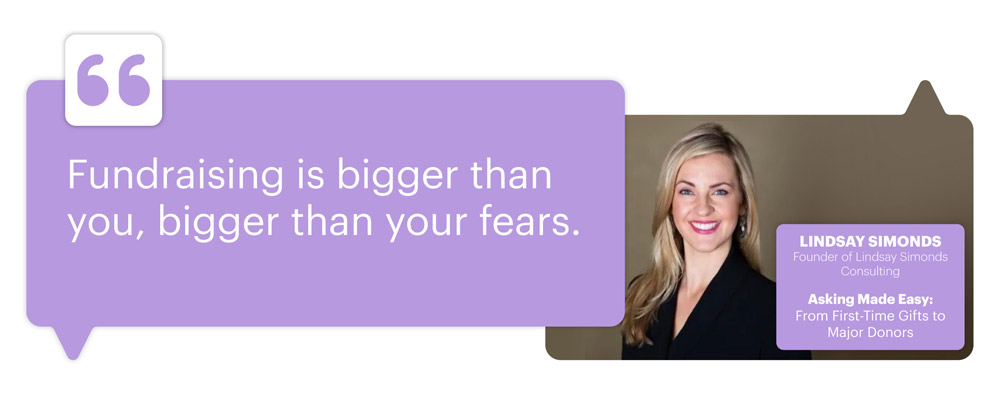
Lindsay’s background: Lindsay Simonds Consulting was founded in 2017 to guide nonprofit clients in navigating transformational changes. Lindsay has led teams that have raised over $1 billion in new philanthropic funding, and she brings clients her eye for major gifts strategy, structures of influence, community engagement, project management, compelling storytelling, and brand evangelism.
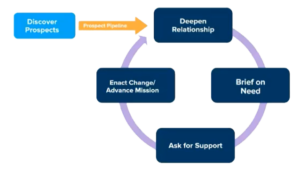
Lindsay’s practical session began with the mechanics of making an ask and then went into the art of soliciting new and increased gifts through storytelling. Lindsay breaks down the nonprofit prospect pipeline into four recurring steps. After discovering prospects, nonprofits should work to deepen the relationship, brief them on the current needs of their mission, ask for support, enact the change that their support made possible to ultimately advance the mission, and then repeat.
A few things to remember if you can relate:
Find donors through affinity, ability, & access
Once your solicitation process is set, the question becomes, how do you find prospective donors to enter your pipeline? Lindsay recommends identifying donors through affinity, ability, and access. In other words, who is within a few degrees of separation from your organization?
To assess donors by affinity, you would look at their philanthropic track records. Do they give gifts to similar causes? Do they give in your region? Are they grateful alumni? Ability refers to their financial capacity to give, determined by prior giving to your organization and/or sector. Access is determined by a direct or indirect relationship with your organization and a willingness to engage.
But how do you keep track of all this information, especially if you are gathering it all yourself? Lindsay recommends creating an internal rating system based on affinity, ability, and access, or segmenting your database as follows:
As far as engagement, In the interest of saving time and headaches, Lindsay recommends making your work more “bite-sizeable.” You can do this by making a plan for each segment based on your capacity, like an email each Monday or a newsletter each quarter, and getting creative with your outreach. She points out that there are plenty of different engagement opportunities to discuss with donors aside from giving, like sponsoring an event, funding a guest speaker, volunteering, establishing planned giving, and more.
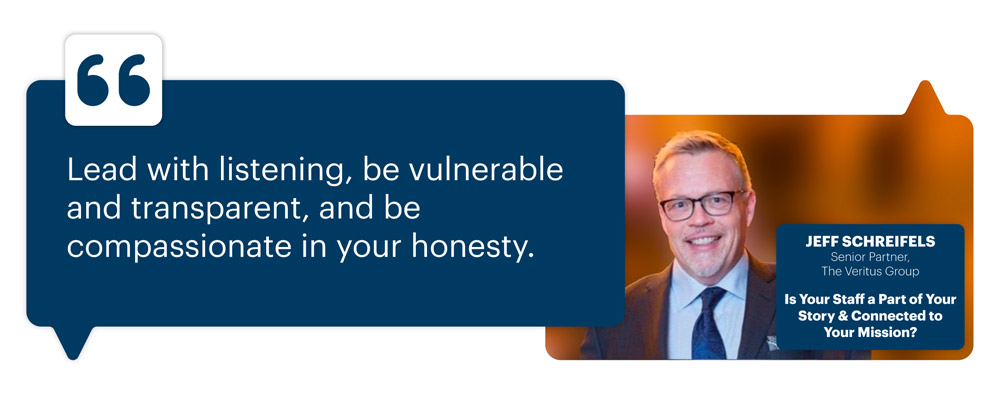
Jeff’s background: When it comes to advising nonprofit directors on their staff, the Veritus Group has developed a strategic approach built on data and experience training thousands of clients around the world, working with organizations large and small.
Jeff began his session by addressing “The Great Resignation” – more than 4 million Americans have quit their jobs every month for 11 months, according to Bureau of Labor Statistics data as of April 2022, and 51% of current fundraisers will leave their organization within the next two years. He puts the onus on nonprofit executives: “Your staff is your most important asset, and it’s up to you to address issues that could cause people to leave your organization,” Jeff says.
According to Schreifels, the issues plaguing nonprofit industry staff are “too many non-caseload-related tasks and unclear job descriptions, metrics, and expectations,” adding that celebrating employees is not currently part of the culture. “They don’t feel valued, and there’s no structure for success or opportunity for growth,” he says.
The impact of unclear expectations and devalued employees is loss of revenue (spent rehiring and retraining) and stagnant fundraising programs (getting passed from employee to employee). Short-sighted organizations may even refuse a raise to frontline fundraisers (who are generating more revenue over time) because of certain policies or criteria. So the cycle continues until nonprofit leadership changes its ways.
How to set clear expectations:
How to demonstrate value:
Attendees share their wins
“In a previous role, I added an agenda item to our regular staff meeting: ‘What do we need to know or celebrate?’ It was a big success as it allowed staff to both plug in their own accomplishments and also acknowledge others.”
– Cara Palladino, FWCC Americas
“As a steering member of our internal Diversity and Inclusion Committee, I suggested a ‘capacity check-in’ at the beginning of our monthly meetings. We volunteer our time to the committee, in addition to our roles with DonorPerfect, so it’s very helpful to know who will have the capacity to work on our presentations and newsletters.”
– Allyshia Dycus, DonorPerfect
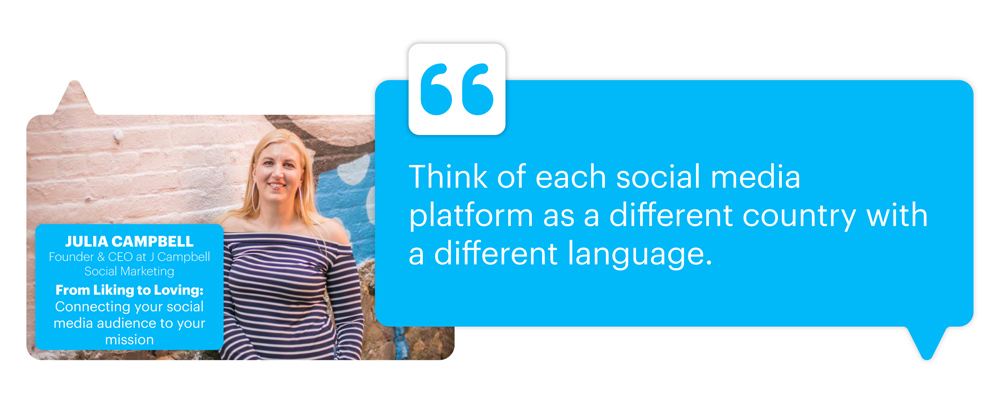
Julia’s background: Named as a top thought leader by Forbes and BizTech Magazine, Julia Campbell is an author, speaker, and nonprofit consultant on a mission to make the digital world a better place. She launched the podcast Nonprofit Nation this year, and has written two books for nonprofits on social media and storytelling. Julia’s online courses, webinars, and talks have helped hundreds of nonprofits make the shift to digital thinking and raise more money online.
In order to determine the goals that nonprofits want to achieve through social media, Julia addressed why donors stop giving to an organization in the first place. Then she examined what keeps donors giving to the same organization.
Why donors stop giving, according to Dr. Adrian Sargeant’s research:
A few ways to fulfill donor needs through social media:
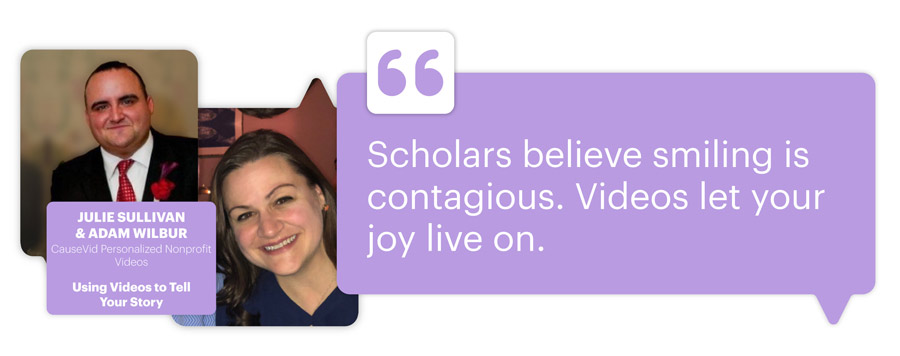
Plenty of fundraisers are still wondering, why video? Even though video marketing is growing in popularity, in the nonprofit sector and in general, fundraisers may have trouble seeing how it fits their mission and finding the time to pull it off. This session, delivered by nonprofit video experts and fellow fundraisers, argues that any trouble is worth working through. Video marketing leads to more opens, clicks, and memories – viewers retain 95% of a message when they watch it in a video compared to 10% when reading it in text, according to Insivia research. Plus, videos don’t need to be produced – a phone or webcam recording works just as well.
Simply put, people give to people, and they crave an authentic connection that they cannot get through automated tax receipts or gift acknowledgments. Putting a human face to your communications establishes this connection, allowing you to effectively communicate your story and your organization’s impact on your community. Videos capture the emotion in a person’s voice and the expressions on their face.
Ideas for mission advocates
Real-life examples
About DP Video
Using DP Video, nonprofits can send personalized video emails straight from a donor’s profile in DonorPerfect. In fact, all DonorPerfect users can try DP Video for free and send 10 trial videos. So how does it work? Nonprofits can add a second video to play directly after the first, and/or add a call to action button for donations.
To request a video from a board member, constituent, or beneficiary, simply send them a unique link to record and submit their video back to you. One link can be sent to multiple people to collect testimonials and store them in your video library. These request links are mobile responsive and videos can easily be recorded on a phone. Then, you can send the video to donors if you choose.
DP Video can be used in-person at events, for guided interviews via Zoom, for donor stewardship, or for scheduling meetings – any communication you want to put a face to – and these engagements are generally easier to track than handwritten notes or calls.
Follow us on social!